Measuring Progress in Sustainable Development Goals (SDGs): An Application of Natural Language Processing (NLP) on Budget Documents - ఆర్బిఐ - Reserve Bank of India
Measuring Progress in Sustainable Development Goals (SDGs): An Application of Natural Language Processing (NLP) on Budget Documents
|
by Rajni Dahiya and Shashi Kant^ This article examines the progress in terms of focus on SDGs across the Union Government and select States in India by looking at the budget documents. Using topic modelling, each theme is assigned to one or more SDGs based on multi-label classification, to determine whether there are systematic or structural differences in policies on SDGs as outlined in budget documents. Results show that the combined focus on SDGs by the Union Government and select States has increased in 2023 compared to 2012. It is observed that the emphasis on different SDGs varies over time depending on the changing circumstances and there is considerable heterogeneity among the Union Government and select States with reference to their focus on the individual SDGs. Introduction SDGs are a set of 17 ambitious global goals tackling critical challenges i.e., poverty, inequality, climate change, and environmental degradation which emerged from the Rio+20 conference in 2012 and were formally adopted by all United Nations (UN) member countries in 2015 (Table A1 in Annex provides a detailed description of each of these goals).1 SDGs are successors to the millennium development goals (MDGs) of 2000, but they go further by building upon previous successes and lessons learned. They offer a framework for collaborative action towards a more sustainable and equitable world by 2030. Comprehending the advancements achieved for each goal under SDG empowers policymakers, organisations, and individuals to take purposeful, outcome-driven actions. Taking a step in this direction, the first edition of the SDG India Index was launched in December 2018, incorporating 62 indicators from 39 targets across 13 SDGs.2 NITI Aayog releases the SDG India Index, which assesses the progress made by all States and Union Territories (UTs) towards achieving the SDGs by utilising the latest data provided by ministries and departments. The index is based on the National Indicator Framework developed by the Ministry of Statistics and Programme Implementation (MoSPI) in consultation with NITI Aayog. Normalised scores are calculated for each State/UT and the composite index of a goal is computed using an arithmetic mean of the normalised values of all indicators related to the goal. Each indicator within each State/UT is assigned equal weight. This article offers a novel approach to measure progress in SDGs by leveraging advancements in NLP. This approach aims to bridge the data gap in emerging market economies and construct time series in case backward data is not available (Conforti et al., 2020). Additionally, it may help in automated text labelling of vast documents from diverse sources overcoming the limitations of manual labelling, which may be time-consuming and prone to bias (Guisiano et al., 2022). The methodology in this study uses NLP techniques to extract information from budget documents and deploys a large language model (LLM) to study whether there are systematic or structural differences in policies on SDGs as outlined in budget documents. In the digital age, NLP algorithms, especially transformer models, are instrumental in making sense of vast unstructured text data, helping machines process information efficiently (Vaswani et al., 2017). The basics of NLP are presented in the Annex. The available studies on progress in SDGs in India have largely focused on challenges, implementation, and state-wise comparison of performance (Mohandas, 2018; Panda et al., 2018); While several studies have explored the intersection of SDGs and NLP in other country contexts such as Amel-Zadeh et al., (2021) and Matsui et al., (2022), this article contributes to the literature by providing a theme-based SDG classification within large textual datasets. Also, by using a blend of NLP techniques and network analysis to chart relationships among SDGs, this article explores interconnectedness across them. This co-occurrence analysis reveals important thematic connections and identifies potential synergies between the SDGs (Smith et al., 2021; Zhou et al., 2022). Overall, NLP techniques can complement quantitative assessments like the SDG India Index. By analysing budget documents of the Union Government as well as select State Governments based on availability, the article deploys NLP to unveil the government’s overall narrative and messaging surrounding SDGs. It delves into government priorities and narratives through thematic analysis, identifying recurring themes and topics in budget documents, and offering a deeper understanding beyond mere numbers. It also allows for comparative analysis, offering insights into how different government entities tackle SDGs and track trends in the government’s communication focus over time. Accordingly, the remainder of the article is organised as follows: Section II discusses topic modelling; Section III delves into data and methodology; Section IV details the results, and Section V concludes the analysis. II. NLP and Topic Modelling: Some Preliminaries Topic modelling in NLP is an unsupervised learning approach for organising text documents based on their underlying semantic structure. From an algorithmic perspective, topic modelling techniques can be broadly classified into three main categories: algebraic, probabilistic, and neural models (Vayansky et al., 2020; Abdelrazek et al., 2023). The first two fall under traditional statistics-based methods, while the third represents the more contemporary approach of employing artificial neural networks in NLP (Chart 1). Among conventional models, LDA has been the dominant choice for decades (Blei et al., 2003). However, many studies have uncritically applied LDA, neglecting justification for their topic modelling method selection. A significant drawback of LDA is its dependence on the bag-of-words (BoW) approach, neglecting semantic relationships among words (Chen et al., 2023). In general, conventional topic modelling techniques such as LDA necessitate intricate corpus pre-processing, meticulous parameter selection (e.g., determining the number of topics), proper model evaluation, and interpretation of generated topics relying on both common sense and domain knowledge. Recently developed neural models have gained significant popularity since 2016. Examples within the neural category encompass LDA2Vec (Moody, 2016), SBM (Gerlach et al., 2018), deep LDA (Bhat et al., 2020), Top2Vec (Angelov, 2020), and BERTopic (Grootendorst, 2022). This trend aligns with the exponential progress of deep learning in recent years. 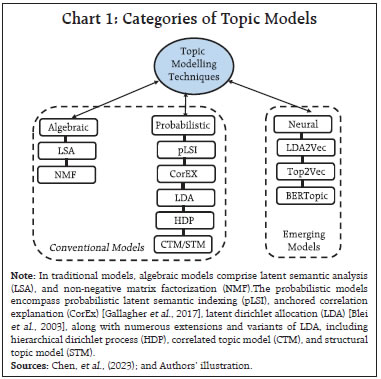 This study utilises budget speeches from select Indian States (Andhra Pradesh, Karnataka, Kerala, Odisha, Tamil Nadu, and West Bengal) and the Union Government, spanning from 2012 to 2023. As shown in Chart 2, after text pre-processing of the respective budget speeches, BERTopic was employed for generating distinct themes as it outperformed traditional models i.e., NMF, LSA, and LDA (Egger et al., 2022; Chen et al., 2023).3 These themes were further classified into specific SDGs using Hugging Face’s pre-trained SDG classifier model.4 It is important to note that this study focuses on the first 15 SDGs, as the pre-trained model is fine-tuned based on publicly available data from the OSDG community (OSDG, 2022) which classifies the data in the first 15 SDGs. In order to measure the evolution of emphasis on SDG goals over time, a key tool in NLP known as TF-IDF5, is used. The intuition behind TF-IDF is that a term’s importance is inversely related to its frequency across documents. This score combines two factors: term frequency (TF) which measures how often a term appears in a document, and inverse document frequency (IDF) which penalises common terms across the entire corpus. 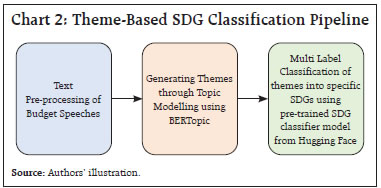 TF-IDF scores are calculated by multiplying TF and IDF.  A detailed explanation about TF-IDF is provided in the Annex. First, the overall evolution of communication strategy in budget documents is analysed. It is found that budget speeches length marginally decreased, in terms of word counts, for the Union Government, Kerala and Karnataka, while it increased for other States in 2023-24 compared to 2012-13 (Chart 3). Looking beyond number of words, an analysis of unique number of topics mentioned in the budgets were attempted. Through topic modelling, amongst the sample states, Kerala’s budget speeches emerged as the most diverse in SDG themes, followed by Karnataka, the Union Government, and Tamil Nadu (Chart 4). 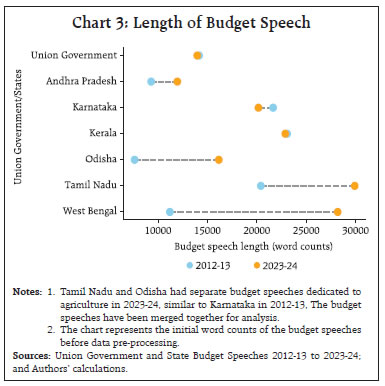 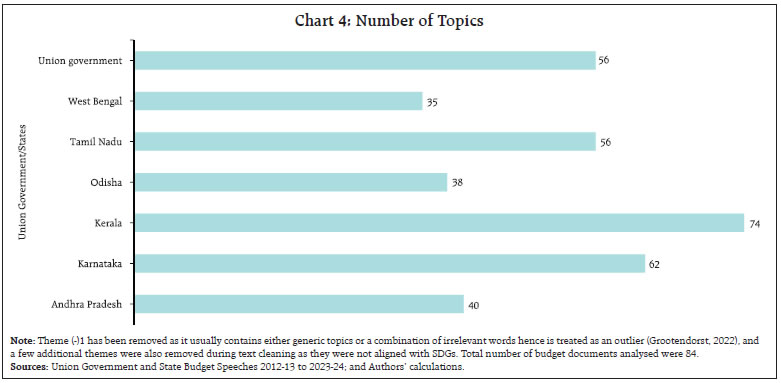 IV.1 Transition in SDGs Focus over Time Results show that the combined focus by the Union Government and select States has increased in 2023-24 compared to 2012-13 on all fifteen SDGs, indicating their stronger commitment towards achieving these goals by 2030. In particular, the focus on zero hunger (SDG 2), good health and well-being (SDG 3), reduced inequalities (SDG 10), sustainable cities and communities (SDG 11), and responsible consumption and production (SDG 12) has witnessed a remarkable increase in 2023-24 compared to 2012-13 (Chart 5). 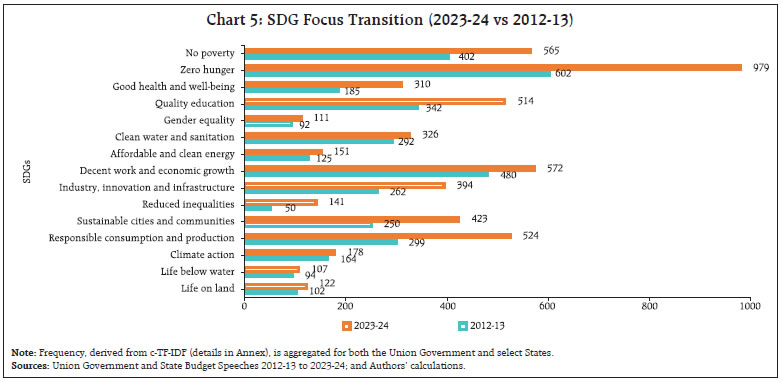 IV.2 Trend in SDGs To delve deeper into the trends within the key SDGs across 2012-13 to 2023-24, the combined focus by the Union Government and select States on the first four SDGs was analysed. This analysis reveals variation in focus over the years. In 2023-24, both no poverty (SDG 1) and zero hunger (SDG 2) reached their highest focus (Chart 6a and 6b). The COVID-19 pandemic significantly impacted the focus on good health and well-being (SDG 3), with a steep rise in 2021-22, reaching its highest level in the last nine years (Chart 6c). For quality education (SDG 4), both 2018-19 and 2023-24 saw significant reforms in the education sector. Key schemes i.e., Samagra Shiksha Abhiyan6 (2018) and the National Education Policy (2023) mark these years as pivotal for education development in India (Chart 6d). 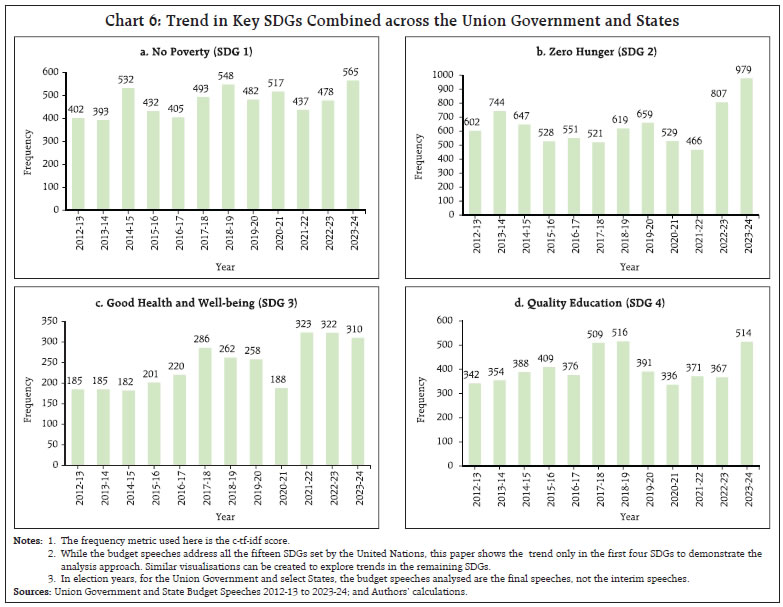 IV.3 Mapping the Interconnectedness of the SDGs: A Co-Occurrence Analysis SDGs are not mutually exclusive and targeting a particular SDG may help achieve other linked goals as well. Analysing these co-occurrences renders valuable insights into the interconnectedness of the SDGs which helps in the identification of integrated policy approaches that address multiple goals simultaneously. The analysis of co-occurrence of SDGs based on overlapping themes is presented in Chart 7. The theme related to renewable energy was tagged with affordable and clean energy (SDG 7), responsible consumption and production (SDG 12), and climate action (SDG 13) because renewable energy directly addresses the goal of providing clean and affordable energy, promoting sustainable consumption practices and mitigating climate change risk. Similarly, a theme focused on forests and biodiversity was tagged with climate action (SDG 13) and life on land (SDG 15). This reflects the crucial role forests play in sustaining life on land and mitigating the impact of climate change. 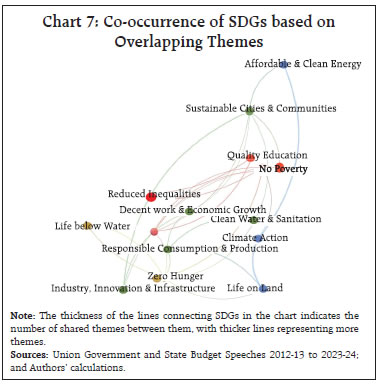 IV.4 Policy Alignment between the Union Government and States Amel-Zadeh et al. (2021) employed NLP techniques to pinpoint companies that aligned with the UN SDGs through the analysis of the text in their sustainability disclosures. The same principles may be extended to measure alignment of the Union Government and States with various SDGs. A priori, policy focus of the Centre and the States is expected to be different and also could vary over time. The constitution divides subjects of governance into three verticals i.e., Union, States, and Concurrent lists. This gives the national and sub-national governments the freedom and space to act on the subjects in their jurisdiction with some degree of overlap in the concurrent list where the two can cooperate and complement each other’s policies. The States can make policies fine-tuned to suit their local conditions. The hypothesis gets reaffirmed when this study reduces the dimensionality of the 15 SDGs to a 2-dimensional plane using two principal components. Each budget document can be represented by a 15x1 vector in terms of the focus it has on various SDGs. To visualise the orientation of policies, the dimensionality is reduced from a 15-D space to a 2-D space by plotting the first two principal components which together represent 47 per cent of the total variance (Table 1). The visual representation depicts that the topics covered in budget documents of Union Government (cluster highlighted by black dots). and States are segregated from each other (Chart 8). While policies of some States show less variance across the years, others display considerable diversity in emphasis on SDGs. The Union Government exhibits the least variance across the years compared to the States (Table 2). These differences suggest that the State level policies might be devised keeping in view their local situations. 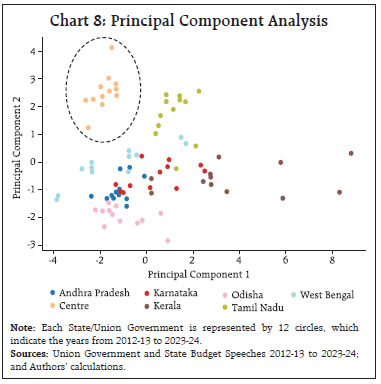 NLP has become an invaluable tool for enhancing data analysis and is increasingly being applied in policymaking. This article proposes a novel use of NLP to measure progress towards SDGs in the Indian context, complementing existing quantitative approaches. The analysis undertaken for the Union Government and select States indicates that their combined focus on SDGs was higher in 2023-24 as compared to 2012-13 pointing towards a stronger commitment towards achieving these goals by 2030. The focus on various SDGs has varied over time depending on the changing circumstances such as an increase in focus on health during the COVID-19 pandemic. It is also found that SDGs are not mutually exclusive and exhibit significant interconnectedness between them. Therefore, targeting a particular SDG may help achieve other linked goals too. Furthermore, this approach helps to check the heterogeneity in focus on SDGs among Union Government and select States. Going beyond the traditional quantitative measures, the analysis of relative focus on SDGs presented in this article provides important policy insights into the evolution, interconnectedness, and relative focus over time.
References Abdelrazek, A., Eid, Y., Gawish, E., Medhat, W., and Hassan, A. (2023). Topic Modeling Algorithms and Applications: A Survey. Information Systems, 112, 102131. Amel-Zadeh, A., Chen, M., Mussalli, G., and Weinberg, M. (2021). NLP for SDGs: Measuring Corporate Alignment with the Sustainable Development Goals. Social Science Research Network (SSRN). Amin, A., Hassan, S., Alm, C., and Huenerfauth, M. (2022). Using BERT Embeddings to Model Word Importance in Conversational Transcripts for Deaf and Hard of Hearing Users. ResearchGate Publication. https://doi.org/10.13140/RG.2.2.28272.33289 Anastasopoulos, L., Moldogazi, T., and Scott, T. (2017). Computational Text Analysis for Public Management Research. SSRN Electronic Journal, doi:10.2139/ssrn.3269520. Angelov, D. (2020). Top2vec: Distributed Representations of Topics. arXiv 2020, arXiv:2008.09470. Antonellis, I., and Gallopoulos, E. (2006). Exploring Term-Document Matrices from Matrix Models in Text Mining. arXiv: cs/0602076. Bhat, M. R., Kundroo, M. A., Tarray, T. A., and Agarwal, B. (2020). Deep LDA: A New Way to Topic Model. Journal of Information Optimization Sciences, 41, 823–834. Blei, D. M., Ng, A. Y., and Jordan, M. I. (2003). Latent Dirichlet allocation. Journal of Machine Learning Research, 3, 993–1022. Camacho-Collados, J., and Pilehvar, M. T. (2017). On the Role of Text Pre-processing in Neural Network Architectures: An Evaluation Study on Text Categorization and Sentiment Analysis. arXiv, 1707.01780. Cavnar, W. B., and Trenkle, J. M. (1994). N-Gram- Based Text Categorization. Proceedings of SDAIR-94, 161–175. Chen, W., Rabhi, F., Liao, W., and Al-Qudah, I. (2023). Leveraging State-of-the-Art Topic Modeling for News Impact Analysis on Financial Markets: A Comparative Study. Electronics, 12(12), 2605. Christian, H., Agus, M., and Suhartono, D. (2016). Single Document Automatic Text Summarization using Term Frequency-Inverse Document Frequency (TF-IDF). ComTech: Computer, Mathematics and Engineering Applications, 7, 285. Conforti, C., Hirmer, S., Morgan, D., Basaldella, M., and Ben Or, Y. (2020). Natural Language Processing for Achieving Sustainable Development: The Case of Neural Labelling to Enhance Community Profiling. ACL Anthology. Devlin, J., Chang, M.-W., Lee, K., and Toutanova, K. (2019). BERT: Pre-training of Deep Bidirectional Transformers for Language Understanding. North American Chapter of the Association for Computational Linguistics. Egger, R., and Yu, J. (2022). A Topic Modeling Comparison Between LDA, NMF, Top2Vec, and BERTopic to Demystify Twitter Posts. Frontiers in Sociology, 7. Gallagher, R. J., Reing, K., Kale, D., and Ver Steeg, G. (2017). Anchored Correlation Explanation: Topic Modeling with Minimal Domain Knowledge. Transactions of the Association for Computational Linguistics, 5, 529–542. Gerlach, M., Peixoto, T. P., and Altmann, E. G. (2018). A Network Approach to Topic Models. Science Advances, 4, eaaq1360. Grootendorst, M. (2022). BERTopic: Neural Topic Modeling with a Class-based TF-IDF Procedure. arXiv 2022, arXiv:2203.05794. Guisiano, J. E., Chiky, R., and De Mello, J. (2022). SDG-Meter: A Deep Learning Based Tool for Automatic Text Classification of the Sustainable Development Goals. United Nations Environment Program, Paris, France. Hachaj, T., and Ogiela, M. R. (2018). What Can Be Learned from Bigrams Analysis of Messages in Social Network? In 2018 11th International Congress on Image and Signal Processing, Biomedical Engineering and Informatics (CISP-BMEI) [pp. 1-4]. Beijing, China. doi:10.1109/CISP-BMEI.2018.8633108. Khyani, D., and B S, S. (2021). An Interpretation of Lemmatization and Stemming in Natural Language Processing. Shanghai Ligong Daxue Xuebao/Journal of University of Shanghai for Science and Technology, 22, 350-357. Kurniasih, A., and Manik, L. P. (2022). On the Role of Text Pre-processing in BERT Embedding-based DNNs for Classifying Informal Texts. International Journal of Advanced Computer Science and Applications (IJACSA), 13(6). Matsui, T., Suzuki, K., Ando, K., Kitai, Y., Haga, C., Masuhara, N., and Kawakubo, S. (2022). A Natural Language Processing Model for Supporting Sustainable Development Goals: Translating Semantics, Visualizing Nexus, and Connecting Stakeholders. Sustain Sci, 17, 969–985. Moody, C. E. (2016). Mixing Dirichlet Topic Models and Word Embeddings to make Lda2vec. arXiv, arXiv:1605.02019. Mohandas, P. (2018). Sustainable Development Goals (SDGs) - Challenges for India. Indian Journal of Public Health Research & Development, 9(1), 1. https://doi.org/10.5958/0976-5506.2018.00172.9 OSDG, UNDP IICPSD SDG AI Lab, and PPMI (2022). OSDG Community Dataset. Zenodo. https://doi.org/10.5281/zenodo.6831287. Panda, R., Sethi, M., and Agrawal, S. (2018). Sustainable Development Goals and India: A Cross-Sectional Analysis. OIDA International Journal of Sustainable Development, 11(11), 79-90. Retrieved from https://ssrn.com/abstract=3308074 Sharma, D., and Jain, S. (2015). Evaluation of Stemming and Stop Word Techniques on Text Classification Problem. International Journal of Scientific Research in Computer Science and Engineering, 3(2), Page Range. ISSN: 2320-7639. Retrieved from www.isroset.org. Smith, T. B., Vacca, R., Mantegazza, L., et al. (2021). Natural Language Processing and Network Analysis provide Novel Insights on Policy and Scientific Discourse around Sustainable Development Goals. Scientific Reports, 11(1), 22427. https://doi.org/10.1038/s41598-021-01801-6 Vaswani, A., Shazeer, N., Parmar, N., Uszkoreit, J., Jones, L., Gomez, A. N., Kaiser, Ł., and Polosukhin, I. (2017). Attention Is All You Need. In Proceedings of the Conference on Neural Information Processing Systems. Vayansky, I., and Kumar, S. A. P. (2020). A Review of Topic Modeling Methods. Information Systems, 94, 101582. Webster, J., and Kit, C. (1992). Tokenization as the Initial Phase in NLP. Proceedings of the 14th Conference on Computational linguistics - Volume 4, 1106-1110. https://doi.org/10.3115/992424.992434. Zhou, X., Jain, K., Moinuddin, M., and McSharry, P. (2022). Using Natural Language Processing for Automating the Identification of Climate Action Interlinkages within the Sustainable Development Goals. In Association for the Advancement of Artificial Intelligence (AAAI) 2022 Fall Symposium on the Role of AI in Responding to Climate Challenges.
I. Primer on NLP a. Terminology The fundamental unit of analysis in NLP is the “term”, which can be either a single word like “development” or a sequence of words known as “n-grams” (Cavnar et al., 1994). While words retain their conventional meaning, n-grams represent groups of words treated as a single unit for analysis. Examples include “Good Health” and “Quality Education” which are “bi-grams” (Hachaj et al., 2018) often analysed as single terms within NLP tasks. Documents can range from sentences and paragraphs to entire literary works and are typically the primary unit of analysis when analysing text. Here, the documents which are analysed are budget speeches from the Union Government and six States for fiscal years 2012 to 2023. Finally, a corpus is a collection of documents analysed, equivalent to a ‘data set’. In this case, the corpus is the set of budget speeches. The corpus is comprised of multiple documents, each of which is comprised of terms. Anastasopoulos et al., (2017) neatly summarised the NLP processing hierarchy in mathematical notations (Chart A1).  b. From Text to Data Text pre-processing is a critical step in NLP (Kurniasih et al., 2022). It involves several key steps to refine the raw text data before it is converted to numbers. The initial step is tokenisation where text is segmented into individual words or tokens (Webster et al., 1992). Lowercasing is essential for ensuring text consistency by converting all characters to lowercase, making “budget” and “Budget” equivalent in analysis. Stop word removal (Sharma et al., 2015) filters out common, low-information words like “the”, “is”, “are”, etc., so that the focus is on the words that convey meaning. Removing punctuation, such as periods or commas, improves text readability and removes unnecessary clutter. Lastly, stemming or lemmatization (Khyani et al., 2021) simplifies words to their root forms, making sure that words with similar meanings are represented in the same way; “budgeting”, “budgeted” and “budgets” all become “budget” (Chart A2). c. Document–Term Matrix (DTM) A DTM is a key tool in NLP and text analysis, transforming documents into a structured numerical format for analysis (Antonellis et al., 2006; and Anastasopoulos et al., 2017). It represents each document in rows and unique terms in columns, using values to indicate term frequency or presence in documents. Different methods can be used to fill the cells, including TF (term frequency), binary (presence/ absence), and TF-IDF (combining term frequency with term uniqueness) [Christian et al., 2016]. The most common of these is TF-IDF which will be discussed in detail in the next section. 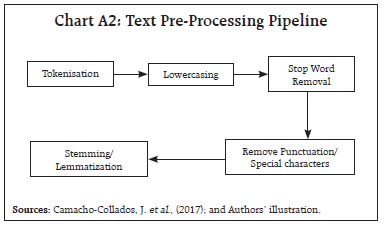 d. Overview of TF-IDF The key intuition behind TF-IDF is that a term’s importance is inversely related to its frequency across documents. This score combines two factors: Term Frequency (TF) measures how often a term appears in a document, while Inverse Document Frequency (IDF) penalizes common terms across the entire corpus. IDF is calculated as:  In this context, t represents the term (word) for which this paper aim to assess commonality, and N stands for the total number of documents (d) in the corpus (D). The denominator corresponds to the count of documents where the term t is present. To prevent divide-by-zero errors when terms are absent in the corpus, IDF calculations typically add 1 to the count of documents containing the term, effectively adjusting the denominator to (1 + count). The popular library scikit-learn solves this by modifying the formula as follows:  Thus, with IDF, infrequent terms stand out, revealing hidden insights within documents. Putting it together: TF-IDF TF-IDF scores, calculated by multiplying TF and IDF.  A term’s relevance within a document is reflected by its TF-IDF score, with 0 representing minimal importance and higher scores signifying increasing significance. This article uses c-TF-IDF which is a class-based TF-IDF procedure that can be used to generate features from textual documents based on the class they are in7. ^ The authors are from the Department of Economic and Policy Research (DEPR). We sincerely thank Dr G.V.Nadhanael for his insightful comments which have significantly improved the quality of the article. The views expressed in this article are those of the authors and do not represent the views of the RBI. 1 United Nations SDGs: https://sdgs.un.org/goals. 2 SDG India Index Methodology, 2018: https://sdgindiaindex.niti.gov.in/assets/Files/SDG%20India%20Index%202018%20Methodology.docx. 3 BERTopic is successful in capturing context and word semantics due to its use of bidirectional encoder representations transformer (BERT) word embeddings (Devlin et al., 2019; Amin et al., 2022). 4 Pre-trained SDG classifier model is available at: https://huggingface.co/jonas/sdg_classifier_osdg. 5 Term Frequency-Inverse Document Frequency (TF-IDF). 6 The Samagra Shiksha scheme is an integrated scheme for school education covering the entire gamut from pre-school to class XII. The scheme treats school education as a continuum and is in accordance with SDG 4. About the scheme: https://dsel.education.gov.in/scheme/samagra-shiksha. |
||||||||||||||||||||||||||||||||||||||||||||||||||||||||||||






















